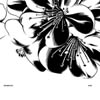Steinbrüschel, "Basis"
 The Room40 label is quickly establishing itself as a touchstone for oblique, esoteric electronic experimentation. So on first glance, this album's cover art of a flower seems somewhat out of place among the austere design and digital graphic manipulations. It is, however, a very appropriate image given that beyond all of the digital processing and trappings, what lies beneath the layers is a subtle, beautifully melodic work that retains the innate warmth of the acoustic instruments that form the source material of these tracks.
The Room40 label is quickly establishing itself as a touchstone for oblique, esoteric electronic experimentation. So on first glance, this album's cover art of a flower seems somewhat out of place among the austere design and digital graphic manipulations. It is, however, a very appropriate image given that beyond all of the digital processing and trappings, what lies beneath the layers is a subtle, beautifully melodic work that retains the innate warmth of the acoustic instruments that form the source material of these tracks.
The relatively brief "Interlude 1" that opens the album sets the precedent for the remaining time well: gentle hovering tones excised from guitar recordings by Lawrence English that are stripped down to their barest melodic essences. Subtle digital buzzing that enshrouds the track gives it a more textural quality that is matched with the deeper electronic pulses well. The remaining "Interlude" tracks, sprinkled throughout the album, all follow a similar mood, probably due to being based on the same source material. That is not to say that they are too similar, which isn't true at all, they simply stay with that formula of an icy, predominant melody with clicky surface noises around the mix, a digital dirtying of otherwise digitally pure sound.
The electronic grime begins to show up a bit more on two more guitar-based tracks, both based on guitar by Ben Frost. Never straying into anything resembling noise or utter dissonance, elements of static creep in and make themselves a bit more pronounced over these two longer tracks. "These 1" is the longer of these two tracks, clocking in at over 17 minutes and, although it is based on extremely simple and repetitive tones, the subtle shifts in dynamics around them keep it from stretching into boredom and instead maintains an hypnotic feel that is not easly ignored.
The remaining track, the 20-minute "Falter," differs not only in its source material (in this case a piano recordings by Bernd Schuer) but in its overall structure and approach. Rather than focusing exclusively on melody, there is more of a rhythmic element here from the more predominant crunchy textural loops and odd transient hums and buzzes. Instead of being all about the melody, it stays more wide open and spacy and feels constantly shifting and changing. Interestingly the raw piano recordings almost come out from the digital processing midway through, which makes for a captivating shift.
Basis is actually a rather warm, inviting take on a style that often is too content to remain in its ivory tower of complexity and cold inorganic sounds. By allowing more of the melody that is associated with the traditional acoustic instruments that form the core of these recordings, Steinbrüchel has also let the humanity in, which makes for a much more pleasant experience, not just those who know how to build a MAX/MSP patch.
samples:



